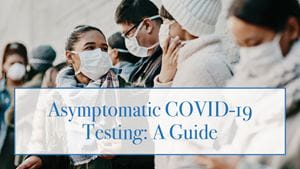
Asymptomatic means you have no symptoms of a possible COVID-19 infection. If you do have symptoms such as fever, cough, shortness of breath, loss of taste or smell, please call your healthcare provider or visit your nearest Rochester Regional Health Urgent Care for a COVID-19 evaluation and possible symptomatic COVID-19 testing options.
Yes, there are at least three different reasons for asymptomatic testing.
Contact your primary care provider or visit an urgent care to be assessed. Based on the circumstances of your exposure and your vaccination history, you may or may not need testing.
Testing is required prior to elective surgeries, procedures and immunocompromising treatments to ensure you do not have a COVID-19 infection.
This is generally not covered by insurance. You will need to find out what type of testing is required for your specific purpose: rapid antigen testing (least expensive), rapid molecular testing, or PCR testing (most expensive).
Most local pharmacies, such as CVS, Walgreens, Rite Aid, and Kinney Drugs, sell COVID-19 rapid testing kits that can be used to test both symptomatic and asymptomatic individuals. Results with these tests are available in as little as 15 minutes. Some local public health departments are distributing home test kits at no cost. Contact your local public health department for more information.
There are circumstances in which you might need or want a COVID-19 test when asymptomatic. Here are some events and occasions in which you may need such asymptomatic testing:
As of May 19, 2021, weddings and other catered events should continue to limit guests indoors to 250 indoors or 500 outdoors. Testing is no longer required for attendance. Event venues are able to require masks for all patrons and social distancing of 6 feet required between parties of attendees, unless all attendees present proof of full vaccination status.
For large-scale events exceeding the State's social gathering limits that are held indoors, proof of recent negative COVID-19 test result for attendees over the age of four is required for unvaccinated attendees. This testing is optional for outdoor event settings.
Travel between the United States and Canada is allowed for fully vaccinated individuals; proof of vaccination is required for those who are eligible. Travelers ages 2 and older must provide a negative molecular COVID-19 test taken within 72 hours of the travel date. Travelers may also provide documentation from a licensed health care provider proving they have recovered from COVID-19 in the 90 days preceding travel.
Be sure to let your test provider know that a molecular COVID-19 test is required before traveling to Canada.
Find out what you need to travel to Canada from the U.S.
Symptomatic travelers must immediately self-isolate and contact their local health department or healthcare provider to determine if they should seek COVID-19 testing.